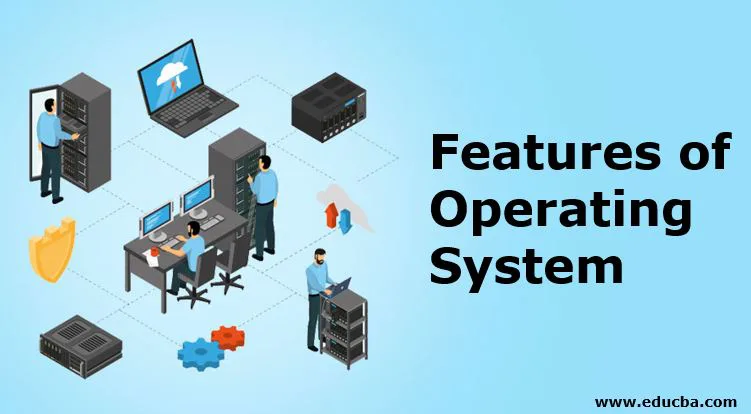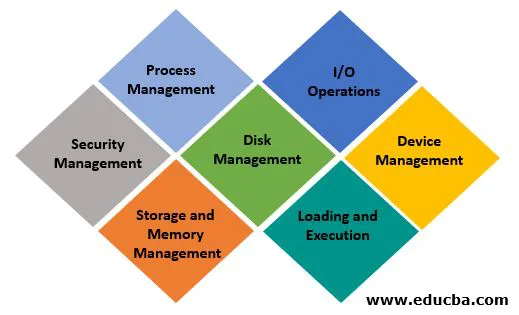
Overview on Features of Operating System
All application such as games, MS office, Firefox requires a suitable environment to execute and perform their task. The operating system helps the user to interact with the system without knowing to work on with the computer language. It is not feasible for anyone to use any smartphones or computers without deploying the operating system. It is mandatory to have at least one operating system to execute the programs and perform the task. So in simple, operating system is defined as the software that acts as a line between computer hardware and end-user for easy interaction to complete the task effectively.
Features of Operating System
There is a wide range of notable features in the operating system which is developing day by day. The growth of OS is admirable because it is developed in 1950 to handle the storage tapes and now it was working as an interface that gives the visual treat for the end-user by throwing brilliant colors. Given below are the features of the operating system:

1. Security Management
The information and confidential data stored in the system is protected by the operating system and block the system by giving strong authorized keys to the user securing the system from malware attack. The operating system acts as supervisor mode and gives the system a strongly protected firewall. OS handle and rectify the errors as soon as possible without any difficulty.
2. Process Management
The program execution is managed effectively by the operating system without any overlapping or time delay. The management of the process supports OS to develop and eliminate process and provides mechanism form communication and synchronization within multiple processes.
3. Storage and Memory Management
OS performs memory management and virtual memory multitasking. The need for memory management in OS is to allocate and de-allocate memory space to process in demand of resources or if they are running out of memory that leads to alerts called file system and disk space is high or full. So it is advisable to view and take back up of the memory and storage devices periodically. The system has many storage hierarchies like primary, secondary, and cache storage. Pseudocode and data should be saved in the Cache so that the running process can refer to it in case of any issues. The operating system can do resource allocation and prevent the system from overloading.
4. Disk Management
OS permits disk access to manage files systems, file system device drivers and related activities of files like retrieval, naming, sharing, storage and protection of files.
5. I/O Operations
OS can effectively handle I/O operations to hide the peculiar behavior of hardware from the end-user.
6. Loading and Execution
The command interpretation is made to interpret the given commands and make the resources to act on the system by processing the commands. The group of processors that don’t share a memory or hardware device is called a distributed system where the processor interacts with another device all through the network. OS coordinates and assigns the interpreters, compilers and other software resources of the different uses of the computer system. Booting is one of the important features of the operating system, that is making the computer’s OS to start and load the computer to work. It is also termed as loading and execution of the computer system. Popular Course in this categoryAll in One Software Development Bundle (600+ Courses, 50+ projects)600+ Online Courses | 3000+ Hours | Verifiable Certificates | Lifetime Access
4.6 (3,144 ratings)Course Price
₹8999 ₹125000
View Course
Related CoursesWindows 10 Training (4 Courses, 4+ Projects)JWS Java Web Services Training (4 Courses, 11 Projects)Java Training (40 Courses, 29 Projects, 4 Quizzes)
7. Device Management
The device and printer controlling are managed by an operating system by permitting a correct flow. Disk management is performed to track all hardware connected to the system and also the resource utilized by different jobs and users. It is one of the responsible for the I/O controller.
Types of Operating System
The most common types of the operating system that is used popularly are Microsoft Windows, Linux, Apple macOS, Google’s Android and Apple’s iOS.

1. Batch Operating System
The batch operating system is a very lengthy and time-saving process. To speed up the same process, a job with the same type of requirements are combined and executed as a group. The user of a batch operating system doesn’t have direct interaction with the computer. Here each user has to schedule the job offline such as punch card and submit it to the computer.
2. Multi-tasking Operating System
A multi-tasking operating system enables the people situated at a different terminal to access a single computer system simultaneously. The CPU’s processor time is distributed among many users is called time-sharing.
3. Real-time Operating System
The military and Space software system is a real-time operating system that has minimum response time for fetching and executing the input commands.
4. Distributed Operating System
The distributed operating system is similar to the time-sharing system, where many processors located in a variety of locations are used by the distributed system to provide fast computing to users.
5. Network Operating System
Networking operating system executes on a server that can serve and manages the data, groups, user, security, application and other networking functions.
6. Mobile Operating System
The mobile operating system is the OS that is designed to power tablets, wearable devices, and smartphones. Some smartphone OS includes BlackBerry, Web, watchOS, Android, and iOS.
OS allows the user to hide the information of hardware by building an abstraction and it is easy to use with GUI. It is a platform for easy deployment of applications of programs. It makes sure that the computer system is comfortable to use. But if any faults in OS, it leads to data loss. So it should be managed with high efficacy. It is expensive for a small firm but it offers a lot of features.
The kernel is the major component of the operating system which manages the communication between software and hardware. Microkernels and Monolithic are two popular kernels used for communication purposes. The unique functions of the operating system include process, device, I/O, files and memory management. The important types of operating systems are batch, multi-tasking, real-time, network and mobile operating systems.
Recommended Articles
This has been a guide to Features of Operating System. Here we discuss the introduction, features, and types of operating systems. You may also have a look at the following articles to learn more –
- Threads in Operating System
- Multithreading in Operating System
- Functions of Operating System
- Evolution of Operating System
ALL IN ONE SOFTWARE DEVELOPMENT BUNDLE (600+ COURSES, 50+ PROJECTS) 600+ Online Courses 3000+ Hours Verifiable Certificates Lifetime AccessLearn More0SHARESShareTweetSharePrimary Sidebar
Computer Tutorial
- Computer Basics
- New Technologies Of Computer
- Application Of Computer Graphics
- Types Of Computer Architecture
- Types Of Computer Software
- Components Of Computers
- Computer Input Devices
- Line Drawing Algorithm
- SOAP Web Services Interview Questions
- Web Services Interview Questions
- Microservices Interview Questions
- What Is Windows 10?
- Windows 10 Desktop Mode
- Windows Commands
- Windows Interview Questions
- Windows Networking Commands
- Windows Operators
- Windows Server Interview Questions
- Introduction To Windows
- Top Windows Phone Apps
- Windows Monitoring Tool
- Productivity Tricks For Windows 10
- Computer Network Advantages And Disadvantages
- Computer Network Interview Questions
- Introduction To Computer Network
- Metropolitan Area Network
- What Is Embedded Systems
- Components Of Embedded System
- Embedded Systems Security
- Types Of Computer Network
- Types Of Computer Operating System
- Evolution Of Operating System
- NAS Storage Device
- Windows Administrator Interview
- Types Of Communication Network
- What Is Automata
- Types Of Mainframe Computers
- Types Of Computer Hardware
- Types Of Sensors
- What Is Server
- What Is RPC
- What Is Microservices
- Types Of Computer Virus
- Types Of Computer Keyboard
- Types Of Motherboard
- Sensor Device
- What Is Computer Graphic Design
- Computer Architecture Interview
- What Is Computer Science?
- What Is Bluetooth?
- What Is VLAN?
- Types Of VLAN
- Types Of LAN
- How Does LAN Switches Work
- What Is VLAN Network?
- What Is Native VLAN?
- Switching Modes
- What Is Storage?
- What Is Object Storage?
- What Is Block Storage?
- Block Level Storage
- Cordova Local Storage
- Threads In Operating System
- What Is Gateway?
- What Is Ethernet?
- What Is Virtual Machine?
- What Is A Trunk Port?
- VPN Applications For Android
- What Is A NAS Drive?
- What Is Ring Topology?
- Point To Point Topology
- What Is Mesh Topology?
- Extended Star Topology
- Token Ring Topology
- Physical Topology
- What Is A Hybrid Topology?
- Hybrid Network Topology
- Star Network Topology
- Star Bus Topology
- Zariski Topology
- Ethernet Topology
- Logical Topology
- Partial Mesh Topology
- Types Of Computer Cables
- Types Of Computer Language
- Features Of Operating System
- Functions Of Operating System
- Multithreading In Operating System
- Ethernet Frame Format
- Types Of Memory In Computer
- What Is Heap Memory?
- Cache Memory
- Cache Memory Types
- Register Memory
- What Is Register?
- Types Of Registers
- What Is Arduino?
- Arduino Operators
- What Is ISCSI?
- Computer Science Interview Questions
- Types Of USB Ports
- What Is Port
- Daisy Chain Network
- What Is A Monitor?
- What Is Printer?
- Types Of Printers
- What Is WPS
- What Is Mouse?
- Types Of Mouse
- Types Of Socket
- Transmission Modes
- Computers Output Devices
- Memory Units
- Secondary Memory
- What Is Memory Card?
- Types Of Memory Cards
- What Is Intranet?
- Central Processing Unit
- Computer Ports
- What Is CPU Register
- Types Of CPU
- Types Of Compact Disc
- What Is A Motherboard?
- Types Of LED
- Types Of Processor
- Types Of Primary Memory
- Helpdesk Tool
- What Is Optical Fiber?
- Windows 10 Creation Tool
- Unguided Media Types
- Microcontroller Architecture
- ARM Architecture
- What Is NVME?
